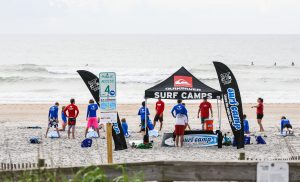Posted by Sinead Eksteen | 01.26.2018 | Adult Surf Camps, Costa Rica Surf Camp, Family Surf Camps, Kid Summer Camps, Learn To Surf, Surfing Lessons, Teen Camps
The Informed Surfer-Part 2 of 6
Informed Surfer Part 2
Personal Bubbles
One of the first things we teach our youngest campers on the first day of camp is to respect personal bubbles. This typically starts as respecting other campers’ personal space (our youngest campers are 6) but it has much bigger implications. Many of our participants, old and young, do not live at the beach and are not familiar with some of these social norms. These norms protect our beaches and the everyday beach goers. The point of that in-field discussion, as well as this one, is to make participants aware of their immediate sphere of influence in and out of the water. This protects you, other beach goers, and our beaches.
Your immediate sphere of influence, or the immediate area in which you affect, is where you set your stuff on the beach and where you are in the water. Let’s start with your location on the beach. Here are some things you should look for.
Empty Space

We post our camps where there are less people. This is for safety and to respect their space.
Seemingly obvious enough, but many non-locals go to the major beach accesses, like C Street or Johnny Mercer Pier, where it’s crowded. If you have a ton of stuff, i.e. surfboards, coolers, and chairs, then you should move down the beach a little so that you aren’t encroaching on other peoples’ space. Having people kick sand on you every time they walk past because there is no avenue to the water, can ruin your beach day.
Secondly, that empty space closer to the dunes that has all the tire tracks may seem like a good empty spot but those are emergency vehicle paths and should be kept clear. Finally, when looking for empty space, those cool, darker sands closer to the water may also look inviting. However, these are within the high tide line – meaning as the tide rises, it holds the potential to soak your stuff or even sweet it away.
Water access and conditions
If you aren’t planning to go in the water this doesn’t apply to you. If you want to body surf, swim, or float, then you should look for a spot within the lifeguard area. These are marked by black and white checkered flags with a lifeguard stand in the middle. These are no surfing zones so you do not need to worry about getting hit by surf boards.
Also, keep an eye out for other important flags on the beach that denote safety issues. No swim zones (a red flag with a swimmer in a circle, crossed out) exist near piers (like Johnny Mercer), jetties (Like WB South End), and rip currents. Black flags on life guard stands mean no lifeguard is on duty at that stand. Green, yellow, and red flags denote water conditions. Purple flags can mean dangerous wildlife (usually jellyfish in NC). Only go in the water or paddle out if you have the appropriate abilities for the conditions.
Choosing wisely can drastically affect your beach experience as well as others. If you have enough space, then you aren’t negatively affecting other people and they aren’t negatively affecting you. When you are far enough from the  water, you protect your stuff and minimize the risk of adding to the debris in the ocean. If you consider the water access and conditions you minimize the risk of a dangerous incident for yourself and/or others. Be aware of your surroundings in and out of the water. Make sure the place that you choose to swim isn’t in a rip current or near surfers. Be safe and have fun!
water, you protect your stuff and minimize the risk of adding to the debris in the ocean. If you consider the water access and conditions you minimize the risk of a dangerous incident for yourself and/or others. Be aware of your surroundings in and out of the water. Make sure the place that you choose to swim isn’t in a rip current or near surfers. Be safe and have fun!







 RENTALS
RENTALS LESSON
LESSON CAMPS
CAMPS ABOUT
ABOUT SHOP
SHOP